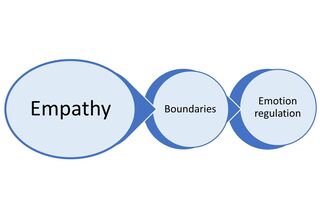Empathy
Are We Still Empathic if We Don't Take Action?
We use empathy to understand others, but what follows is separate.
Posted March 29, 2022 Reviewed by Ekua Hagan
Key points
- Empathy is a gateway to action. What one does next is the result of a separate decision.
- Actions informed by empathy tend to be prosocial, which helps us cooperate and live productively with others.
- Sometimes, fixing situations or telling others what to do is not the most empathic way to respond.
There is much going on in the world today that touches us deeply and evokes empathy. But the events we see may be thousands of miles away, and while we feel moved emotionally, we may not know what to do or how to respond. I have been asked what that lack of action or not knowing what to do means. Is it that we are not empathic enough?
The answer for some may be yes, but for most of us the answer is no; we are experiencing empathy. However, taking action is separate from empathy. We may have an abundance of empathy but what follows those feelings is complicated.

What follows when we feel empathy?
There is a lot of research on the connection between empathy and prosocial behavior, which describes positive voluntary actions because they benefit other people or society. Numerous controlled experiments have demonstrated that empathy leads people to take actions on behalf of others and to do so without personal gain or even at a cost.1 Empathy also helps us to cooperate with others. We use empathy as a tool to read other people, which helps us to exchange information in helpful ways, and as a result, productively live in social groups.2 While there are other reasons that people might do prosocial things (maybe guilt or desire for recognition) empathy has consistently correlated with positive actions.
Empathy informs action but is not the action itself
We often think of empathy as the evidence of doing good, and yes, the two are related. But they are not the same. Empathy is not an outcome; rather it is an emotive experience that can inform what we do next. The action we might take as a result of empathy is often to be helpful, caring, cooperative, and compassionate, but that is the result of a separate decision.
In our brains, the components of empathy follow different neurological pathways that in the moment all feel simultaneous. However, it is really a sequence of actions in our brains. Empathy is the process of vicariously feeling the experiences or emotions of others and then processing those feelings to try and understand what others are experiencing and feeling. Once we have that moment of understanding, we are leaving empathy behind and making a decision on how to act.
Can we have empathy but not do anything?
There may be times that we have an empathic experience and take action, and there may be times that we do not do anything. Or, we may choose to respond in a way that may not seem to others to look particularly active.
For example, professional therapists can empathically share emotions with their clients, but they must maintain boundaries and regulate their own emotions, which are two key components of the full scope of empathy. With clear boundaries and their own emotions in check, therapists can support and guide clients without taking overt actions. The actions are the work of the client.
The reason that empathy is so important, even if there is no observable action taken, is because we are heard and our feelings are validated. When we feel heard and understood, we feel connected to others in ways that promote positive social interactions.3 Those positive feelings towards others create connections that enhance our personal and social interactions.
How do we know when to act?
There is no formula for when to respond with action to your empathic feelings. When sharing emotions and experiences, we may want to fix situations or tell others what to do, but that is not the most empathic way to respond.
Empathy helps you to communicate to others that they are being heard and understood. Using the key empathy skills of setting boundaries and engaging in emotion regulation, we can pause to recognize our own emotions and not get overwhelmed by those emotions. That pause allows us to think about what to do about a situation that belongs to the other person. It also gives us time to listen and hear the other person. We can clarify what actions are wanted. This pause allows us to act in ways that are beneficial to the other; not act in ways that we imagine would fit or do what we would want.
Empathy is the gateway to understanding others. What we do with that understanding is separate, and although very important, empathy is not the actions we do or do not take.
References
1. Batson, C. D. (2012). The empathy-altruism hypothesis: Issues and implications. In J. Decety (Ed.), Empathy from bench to bedside, 41–54. Cambridge, Mass.: MIT Press.
2. Carter, Harris, & Porges, 2011 Carter, C. S., Harris, J., & Porges, S. W. (2011) Neural and evolutionary perspectives on empathy. In J. Decety & W. Ickes (Eds.), The social neuroscience of empathy, 169–182. Cambridge, Mass.: MIT Press.
3. de Vignemont & Singer, 2006 de Vignemont, F. & Singer, T. (2006). The empathic brain: how, when and why? Trends in Cognitive Sciences, 10 (10), 435-441.


